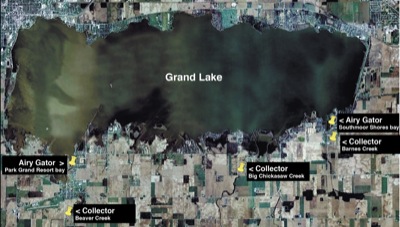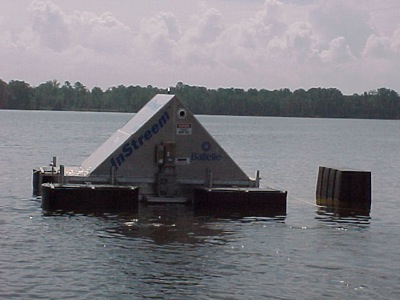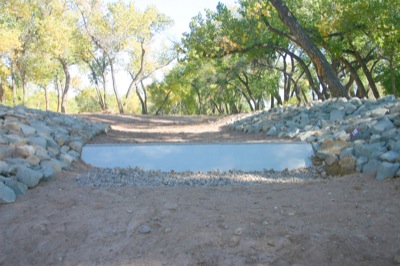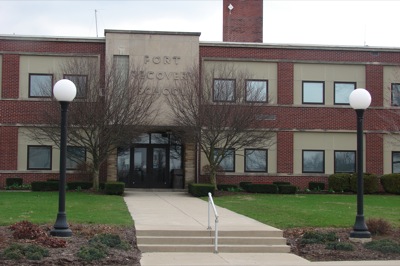Tuesday, March 30th, 2010
Hopes high for lake technology
Test will start in coming weeks
By Nancy Allen

Submitted Photo
The locations of three planned aerating units and three planned sediment traps on the south side of Grand Lake. A local collation hopes the $500,000 technological experiment will show it is feasible to improve the Lake's condition.
GRAND LAKE - A local coalition has raised $332,000 toward $500,000 needed to test sediment removal technology in Grand Lake and three nearby creeks.
The test will involve placing three devices called Collectors in Beaver Creek, Big Chickasaw Creek and Barnes Creek, and two aerating units called Airy Gators in bays at Southmoor Shores and Park Grand Resort. Local officials want to start the test in the next couple of weeks.
During the last few months, the Grand Lake Restoration Initiative has been raising money and giving presentations throughout the community on the technology. The most recurrent question has been, "will this work?"
While that has yet to be proven here, a stormwater manager in Jacksonville, N.C., said aeration units similar to the Airy Gator helped improve the water quality in a 101-acre bay along the North Carolina coast.
Pat Donovan-Potts said Wilson Bay was once so degraded, residents avoided touching its discolored, stinking water. The bay is now home to a variety of wildlife and aquatic animals and people picnic by its shore.
The bay was classified as hypereutrophic, similar to Grand Lake. Hypereutrophic water is nutrient-rich and characterized by frequent and severe algae blooms and low transparency and oxygen levels.
The bay's restoration involved four components: taking a failing wastewater treatment plant that was discharging into the bay off-line, stocking the bay with thousands of oysters to filter the water, constructing wetlands to capture runoff and installing three aerators in the bay.
An Airy Gator is a large, floating electric-powered aerator with a series of rotating discs. The unit infuses oxygen into the water, allowing beneficial microorganisms to grow and eat nutrient-rich organic material in the sediment.
The muck in the bottom of Grand Lake does not have enough oxygen to allow beneficial microorganism to survive and break down organic matter. Therefore, the sludge layer gets thicker as the lake gets shallower. The lake's excessive amount of blue-green algae makes the oxygen problem worse because it leaves a large decaying biomass at the bottom of the lake after it dies.
Donovan-Potts said the aerators helped reduce the sludge layer in Wilson Bay, which sits at the end of a multi-state watershed with a high concentration of hogs and poultry.
"The depth of sediment in the bay has gone down from 9 feet to 6 feet," Donovan-Potts said. "It's decomposed and compacted anywhere from 2 to 3 feet."
Donovan-Potts said it's difficult to attribute how much of the water quality improvement in the bay has been due to the aerators alone, but she said they were a significant part.
"The aeration units were good for delivering oxygen down to the bottom to switch from an anaerobic (oxygenated-depleted) bottom to an aerobic (oxygen-filled) bottom," she said. "If that's what they (Grand Lake officials) are trying to do is get oxygen down there, the units will do that."
John McArthur, who worked on the Wilson Bay project, now works for Findlay-based Streamside Systems, the company providing the aeration units for Grand Lake.
"We installed three, 5-horsepower units in Wilson Bay and we were able to circulate the entire bay," McArthur said. "We set up a test plan, not unlike the one we have for Grand Lake for two bays, and we look to set up sampling points inside and outside the test area."
Along with the aerators, the local coalition hopes to purchase three Collectors, steel devices placed on the bottom of a stream. The device uses the energy of the water to move sediment up a ramp and into a hopper. Once the hopper is full, the sediment is pumped to a dewatering or disposal site.
A soy-based flocculate that causes fine sediment and attached nutrients to bind together into larger particles will be dripped into Big Chickasaw Creek if enough funds are raised. If the flocculate is not added, the Collector will catch mostly sand, McArthur said.
McArthur could not provide the name of anyone who could attest to the successfulness of Collectors, but he did site a study from Duck Creek in Alaska, where a flocculate was successfully added to a stream to bind together high concentrations of dissolved iron.
Local officials are interested in capturing the nutrients before they enter Grand Lake because they feed the lake's blue-green algae. The lake's water quality problems have been known, but last year's announcement by the state that a harmful algae-produced toxin was in the lake made finding a solution more urgent.
Lakeside business owners said they lost money and fewer boats were seen on the lake due to signs warning lake users about the toxin. Many local officials seeking to promote tourism around the lake feel the water quality advisory has given the area a black eye.
With the money raised so far, the coalition will purchase two Airy Gators for the lake and one Collector for Big Chickasaw Creek. The goal is to install them in April and test the technology throughout the summer. Once the data is gathered, local officials hope to use it to leverage state and federal grants for testing on a larger scale.
Jared Ebbing, Mercer County community development director, said the Airy Gators and Collectors are not a "silver bullet" to fix the lake's water quality problems, but said nothing will be gained if nothing is tried.
"Waiting for the state to fund something isn't getting us anywhere," Ebbing said. "I'm hopeful this technology and other technology can begin to help. It may take 10 to 12 activities to help the lake, but if we can look at one or two things at a time and show they have an impact, then we can show the public we are doing our jobs."

Submitted Photo
Airy Gators, giant aerators with rotating discs that infuse oxygen into the water, are proposed to be installed in bays at Southmoor Shores and Park Grand Resort.

Submitted Photo
Collectors, steel devices placed on the bottom of streams that capture sediment and nutrients, are proposed to be placed in Big Chickasaw Creek, Beaver Creek (in Montezuma) and in Barnes Creek.


